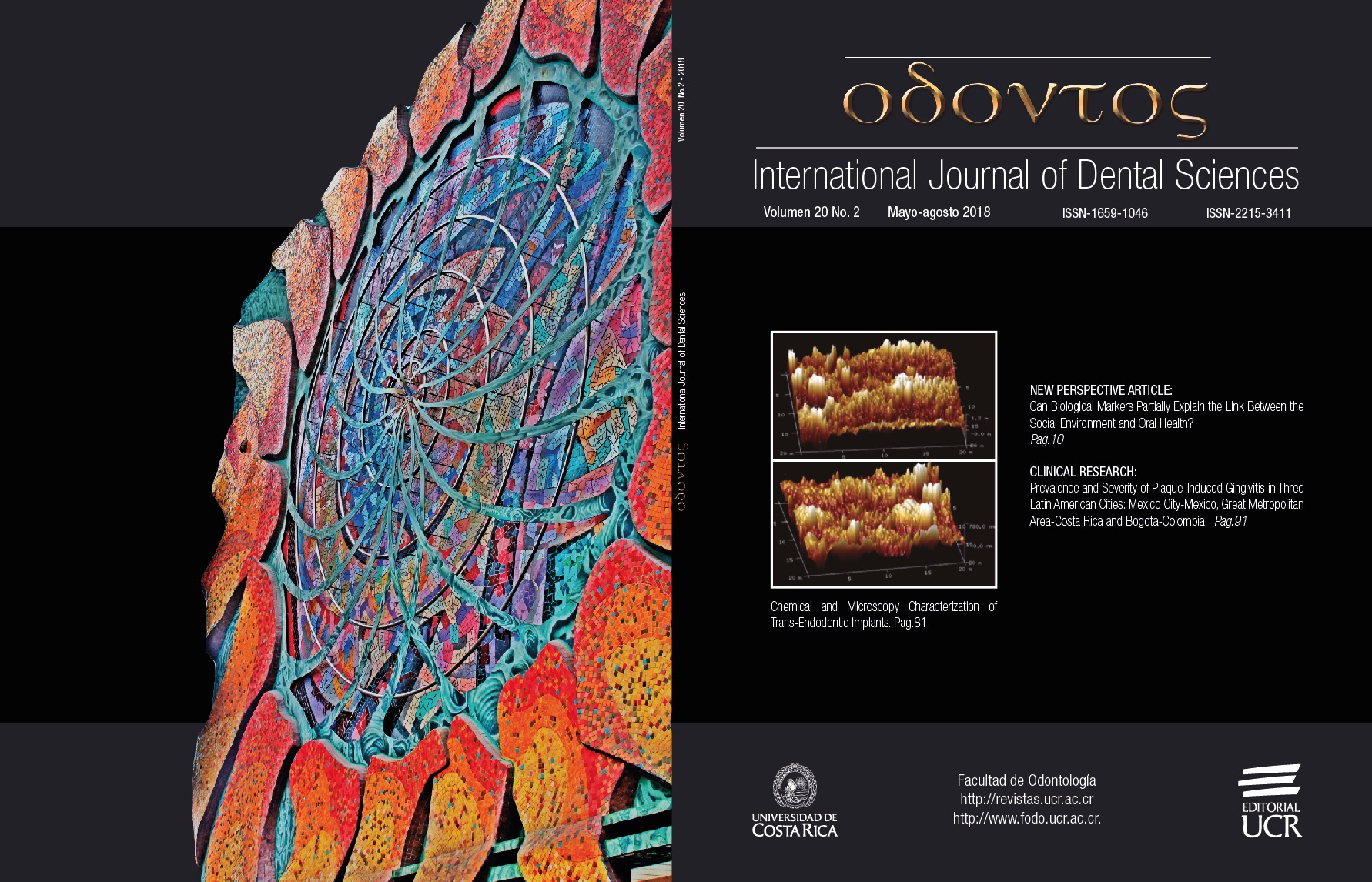Abstract
Trans-endodontic implants are an artificial extension through root apex anchored in periradicular bone tissue. The aim is to improve the crown-root ratio and to provide stability to dental organ present. Zirconium oxide (ZrO2) is a material of great technological importance, having good natural color, high strength, high toughness, high chemical stability, does not suffer any corrosion, chemical and microbial resistance and excellent esthetic properties. Objective: The aim of this study was to evaluate chemical and microscopy of surface conditions of ZrO2 trans-endodontic implant. Materials and Methods: A blocks of ZrO2 were manufactured for produce trans-endodontic implants and divided in two groups: monoclinic and tetragonal phase. They were evaluated using Scanning Electroning Microscope (SEM), Energy-Dispersive X-ray Spectroscopy (EDS), and Atomic Force Microscope (AFM) and Vickers Micro hardness. Results: The Monoclinic phase through AFM analysis showed roughness Ra = 0.320μm, whereas in the Tetragonal phase was 0.126μm, SEM/EDX indicated that the phases are not properly uniform and the addition of the Yttrium to favor the stabilization of the Tetragonal phase. The Vickers hardness analysis showed a value of 1500HV. Conclusion: The characterization of the surface of trans-endodontic zirconium oxide implants provides a guideline to know the surface characteristics of the material, since a greater roughness on the surface of the implant will favor the Osseo-integration capacity.
References
Larios A. Gaitan C. Aguilera L. Aceves M. Diseño, fabricación y evaluación clínica de implantes trans-endodónticos de Óxido de Zirconio. Revista Iberoamericana de Ciencias. 2016; ISSN 2334-2501.
Yadav R. Tikku A. Chandra A. Wadhwani K. Singh M. Endodontic implants. Natl J Surg.2014; 5,70-3.
Santos A. Cava C. Robello J. Implante transendodontico de Cromo-Cobalto. 2004; KIRU.
Cava C. Extirpación de canino retenido y estabilización dental mediante implantes endodónticos. Kiru. 2009; 6 (1), 46-52.
Weine FS. Survival of the endodontic endosseous implant. J Endod. 1993; 19,524-8.
Mittal S. Kumar T. Aggarwal V. Bansal R. Kaur D. Endodontic stabilizers for treating mid root fractures. 20015; 200.78.241.250.
Velázquez R. Vaquero C. Torres D. Jiménez M. Gutiérrez J. Mechanical resistance of zirconium implant abutments: A review of the literatura. Med Oral Patol Oral Cir Bucal. Mar 1 2012;17 (2): e246-50.
A. K. Singh and Umesh T. Nakate. Microwave Synthesis, Characterization, and Photoluminescence Properties of Nanocrystalline Zirconia. The Scientific World Journal Volume, 2014; Article ID 349457.
Y. D. Belo, Q. N. Sonza, M. Borba, A. D. BonaZircônia tetragonal estabilizada por ítria: comportamento mecânico, adesão e longevidade clínica. Cerâmica 2013; 59, 633-639.
Oleshko V. Howe J. Shukla S. Seal S. High-Resolution and Analytical TEM Investigation of Metaestable-Tetragonal Phase Stabilization in Undoped Nanocrystalline Zirconia. Journal of Nanoscience and Nanotechnology. 2004; Vol. 4, No. 7.
Joo J. Yu T. Woon Y. Min H. Wu F. Zhang J. Hyeon T. Multigram Scale Synthesis and Characterization of Monodisperse Tetragonal Zirconia Nanocrystals. J. AM. CHEM. SOC., 2003; 125, 6553-6557.
Hyung-Tae K, Jung-Suk H, Jae-Ho Y. Jai-Bong L. Sung-Hun K. The effect of low temperature aging on the mechanical property & phase stability of Y-TZP ceramics. J Adv Prosthodont 2009; 1: 113-7.
Young-Dan Cho. Ji-Cheol Shin. Hye-Lee Kim. Myagmar Gerelmaa. Comparison of the Osteogenic Potential of Titanium and Modified Zirconia-Based Bioceramics. Int. J. Mol. Sci., 2014; 15, 4442-4452; doi:10.3390/ijms15034442.
Gaurav P. Jayaswal, S. P. Dange, A. N. Khalikar. Bioceramic in Dental Implants: A Review Journal of Indian Prosthodontic Society (March). 2010; 10: 8-12.
Thomas A. Shidar S. Aghyarian S. Watkins-Curry P. Corrosion behavior of zirconia in acidulated phosphate fluoride. J Appl Oral Sci. 2016; 24 (1): 52-60.
Sevilla P. Sandino C. Arciniegas M. Martínez-Gomis J. Peraire M. Gil F. Evaluating mechanical properties and degradation of YTZP dental implants. “ELSEVIER” Materials Science and Engineering C” , 2010; 30 14-19.
Flamant Q. Stanciuc A. Pavailler H. Sprecher C. Roughness gradients on zirconia for rapid screening of cell-surface interactions: Fabrication, characterization and application. Journal of Biomedical Materials Research A | Month 2016 Vol 00a, Issue 00.
Anil S., Anand P. S., Alghamdi H., Jansen J. A. Dental implant surface enhancement and osseointegration. Implant Dent-A Rapidly Evol Pract 2011. 83-108 p.
Sanon C. Chevalier J. Douillard T. Cattani-Lorente. A new testing protocol for zirconia dental implants. “ELSEVIER, Dental materials” 31, 2015; 15-25.
Papia E. Jimbo R. Chrcanovic B. Andersson M. (2014). Surface structure and mechanical properties of impaction-modified Y-TZP. “Dental materials”. 30, 808-816.
Science Associated Editors, L. L. C Instituciones de Educación Superior, “La labor investigadora e innovadora en México”. [Dec. 2016].
Cheyenne, WY 82009. Chapter 2, 103 p. Disponible en http://www.scased.com/images/mx/978-1-944162-16-0.pdf
Apratim, A. Eachempati P. Krishnappa K. Singh V. Chhabra S. Shah S. Zirconia in dental implantology: A review. Journal of International Society of Preventive & Community Dentistry. 2015; 5, 3, 147-156.
Vahabi S. Salman B. Javanmard A. Atomic Force Microscopy Application in Biological Research: A Review Study. Iran J Med Sci June 2013; Vol 38 No 2.
Mota Y. Cotes C. Carvalho R. Machado J. Monoclinic phase transformation and mechanical durability of zirconia ceramic after fatigue and autoclave aging. “Journal of Biomedical Materials Research B: Applied Biomaterials”. 2016; Vol 00b, Issue 00.
Papia E. Jimbo R. Chrcanovic B. Andersson M. Surface structure and mechanical properties of impaction-modified Y-TZP. “Dental materials”, 2014; 30, 808-816.
Inokoshi M. Zhang F. De Munck J. Minakuchi S. Influence of sintering conditions on low-temperature degradation of dental zirconia. Dental Materials. 30, 2014; 669-678.
Turb V. Tuncelli B. Sen D. Golle G. Evaluation of hardness and fracture toughness, coupled with microstructural analysis, of zirconia ceramics stored in environments with different pH values. Dental Materials Journal 2012; 31 (6): 891-902.

